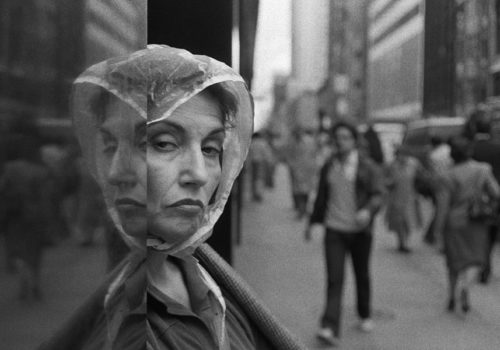This is a mind-blowing and breathtaking work of art and truth and beauty—a fiercely political meditation on justice and injustice, on race and racism, on humanity and inhumanity: to my mind, a sacred book. These are the photographs of an American artist named Richard Sandler, who happens to be one of the best street photographers to ever put humankind in his sight. The Eyes of the City is a collection of snapshots taken in Boston and New York, spanning the late 1970s through the last days before the planes struck on 9/11. These photographs not only stand as powerful, profound, and singular documents of a time, place, and people, but they also speak to timeless—often painful—truths that are as relevant today as they were when Richard captured them.
I first heard Richard Sandlerʼs name 25 years ago. I was working as a radio documentary maker and had just started collaborating with the photographer Harvey Wang. One evening, Harvey told me about a guy who he described as the purest artist heʼd ever met, who ate, breathed, and slept street photography—whose devotion to his craft was singular, monastic, at times even punishing. One day soon thereafter I met Richard as he wandered the streets of the East Village, a camera pressed to his eye. Richard Sandler was everything Harvey described and more.
I visited his railroad apartment/darkroom on East 10th Street a few days later and had my first glimpse of his work—including a good number of the photographs youʼllfind in this collection. Laid out on Richard’s kitchen table were some of the most complex and stirring photographs I had ever seen. Images that shake you hard by the shoulders and remind you whatʼs real and whatʼs really important. Any number of Richardʼs pictures said more about humanity in a single frame than I could hope to capture through tens or hundreds of hours of audio recordings. Not to mention the faces—those faces! I was knocked to my knees.
A few years later, in the mid 90s, I had the good fortune of working with Richard on a project called “The Gods of Times Square.” He had just started to shoot on the street with video, and spent countless hours recording the religious zealots who proselytized in and around Times Square. He showed me some of the footage.
Even though he wasnʼt yet ready to turn it into a video documentary, I suggested that it might make for a good radio feature. I was moving from analog audio (tape edited with razor blades on reel-to-reel machines) to digital, and worked closely with Richard to squeeze the best sounds and stories heʼd collected onto a couple of one-gigabyte drives, (each of which cost $1,000 at the time), to create a documentary that later aired on “All Things Considered” on National Public Radio.
Collaborating with Richard Sandler was a highlight of my career. I learned so much from him— especially about having the courage of your convictions. Those voices, from an older, funkier Times Square, are still with me today.
In the intervening years I’ve been lucky enough to acquire a small collection of Richard’s photographs, which now live on the walls of our family’s house. They never fail to deliver. There are still layers of meaning and mystery that I have yet to peel back. Many are so profound and perfectly composed that they seem like they must have been staged—could this moment have actually unfolded in this way? But it did, and fortunately for us, Richard was there to capture it.
I am looking, for instance, at a photograph hanging in our children’s playroom [the same picture appears on page 116 in this book]. On first glance, an African American mother blocks the camera’s view of her sleeping children. Look again. Are they her children? Why are they leaning into the white woman to their right? Who is the mother? What is their story? Now try this with the other photographs in this collection. Open up this book to any image. Look and learn, get lost, get angry, chuckle at the irony, be moved.
There is something profound and mystical about Richard Sandler’s work, and about the man himself. Not so different from the young boy whose photograph graces the last page of this book, seeming to rise like a phoenix from the fountain, untouched by the water that surrounds him. It’s been said that the best and truest artists live in the margins and suffer for their art. Richard Sandler is the truest artist I’ve ever been blessed to know. This book is a gift to humanity.
Dave Isay
Richard Sandler, The eyes of the city
Published by PowerHouse Books
$ 49.95
















